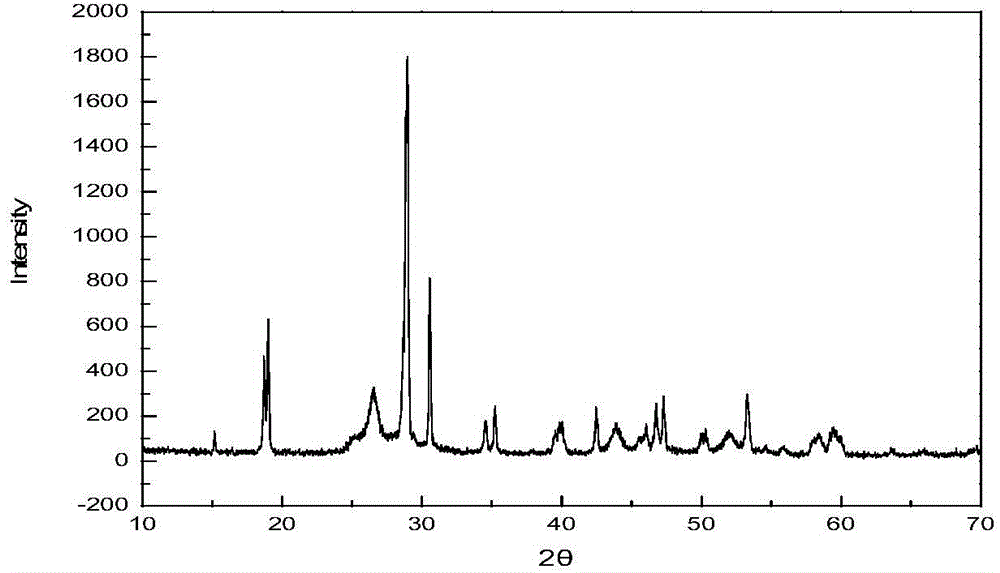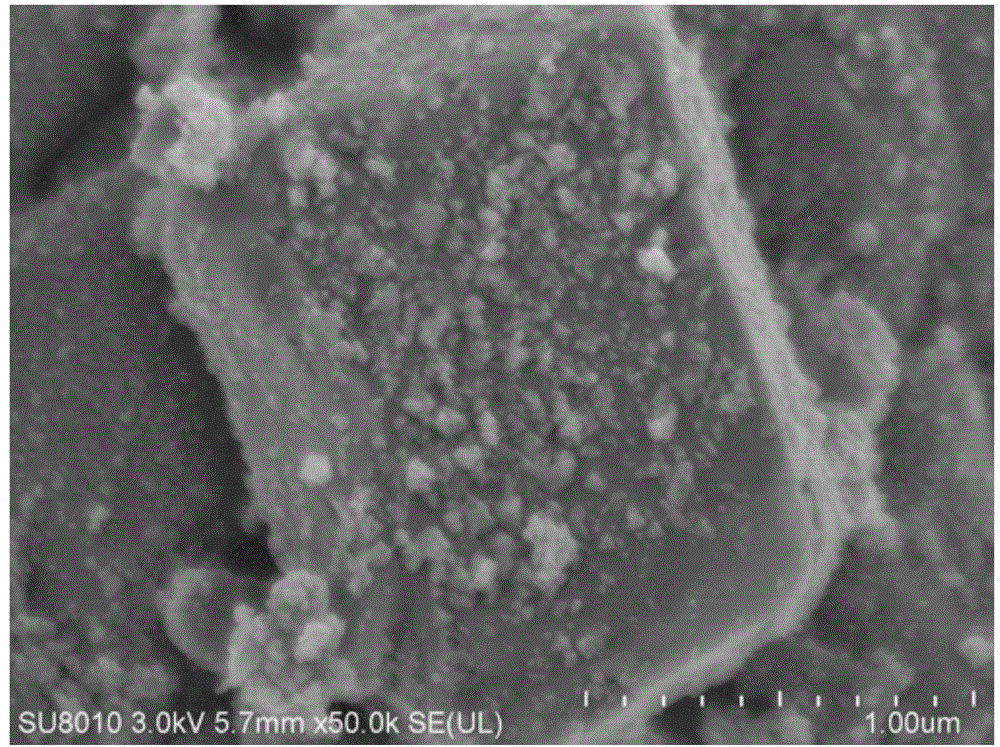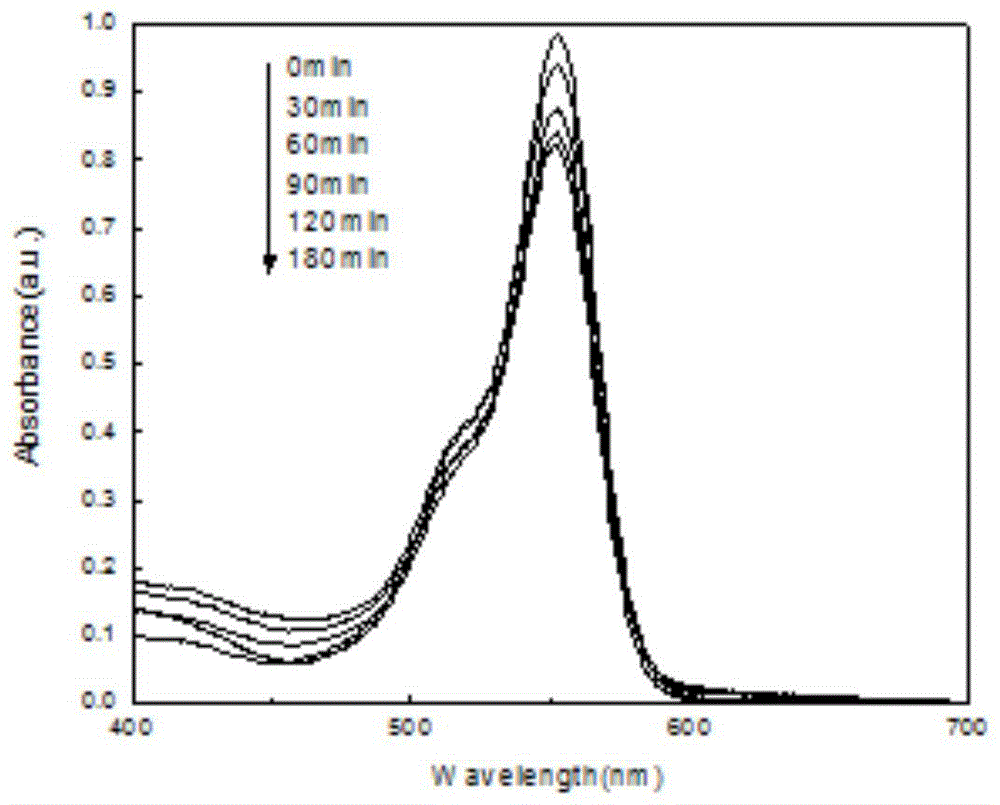CdS/BiVO4 compound semiconductor photocatalyst and preparation and application thereof
A compound semiconductor and photocatalyst technology, applied in physical/chemical process catalysts, chemical instruments and methods, chemical/physical processes, etc., can solve the problems of photocorrosion, reduce the utilization rate of photogenerated holes, etc., and achieve simple raw materials and easy operation. , the effect of reducing costs
- Summary
- Abstract
- Description
- Claims
- Application Information
AI Technical Summary
Problems solved by technology
Method used
Image
Examples
Embodiment 1
[0024] CdS / BiVO of the present invention 4 A compound semiconductor whose nominal composition is xCdS / (1-x)BiVO 4 , where x=0.5, (x represents the molar percentage of CdS in the system), and its specific preparation steps are as follows:
[0025] a) Weigh 1.4552gBi(NO 3 ) 3 ·5H 2 O dissolved in 4mol / L dilute HNO 3 In, weigh 0.351gNH 4 VO 3 Dissolve in 2mol / L NaOH solution, place on a magnetic stirrer and stir for 30 minutes to obtain solutions A and B; slowly drop B solution into A solution under constant stirring, continue stirring for 30 minutes, and then mix the solution Transfer to a high-pressure reactor, add deionized water to 80% of the volume of the reaction lining, adjust the pH to 5; heat to 160 ° C, keep warm for 9 hours; take out and cool naturally, centrifuge the obtained solution, and use deionized water and absolute ethanol Wash 2-3 times and dry at 80°C to get BiVO 4 .
[0026] b) Weigh 0.183gCdCl 2 and 0.264gNa 2 S·9H 2 O was dissolved in 30ml deio...
Embodiment 2
[0029] CdS / BiVO of the present invention 4 A compound semiconductor whose nominal composition is xCdS / (1-x)BiVO 4 , where x=0.5, (x represents the molar percentage of CdS in the system), and its specific preparation steps are as follows:
[0030] a) Weigh 1.4552gBi(NO 3 ) 3 ·5H 2 O dissolved in 3mol / L dilute HNO 3 In, weigh 0.351gNH 4 VO 3Dissolve in 3mol / L NaOH solution, place on a magnetic stirrer and stir for 30 minutes to obtain solutions A and B; slowly drop B solution into A solution under constant stirring, continue stirring for 30 minutes, and then mix the solution Transfer to a high-pressure reactor, add deionized water to 80% of the volume of the reaction lining, adjust the pH to 5; heat to 180 ° C, keep warm for 12 hours; take out and cool naturally, centrifuge the obtained solution, and use deionized water and absolute ethanol Wash 2-3 times and dry at 80°C to get BiVO 4 .
[0031] b) Weigh 0.183gCdCl 2 and 0.264gNa 2 S·9H 2 O was dissolved in 30ml deio...
Embodiment 3
[0033] CdS / BiVO of the present invention 4 A compound semiconductor whose nominal composition is xCdS / (1-x)BiVO 4 , where x=0.4, (x represents the molar percentage of CdS in the system), and its specific preparation steps are as follows:
[0034] a) Weigh 1.4552gBi(NO 3 ) 3 ·5H 2 O dissolved in 2mol / L dilute HNO 3 In, weigh 0.351gNH 4 VO 3 Dissolve in 4mol / L NaOH solution, place on a magnetic stirrer and stir for 30 minutes to obtain solutions A and B; slowly drop B solution into A solution under constant stirring, continue stirring for 30 minutes, and then mix the solution Transfer to a high-pressure reactor, add deionized water to 80% of the volume of the reaction lining, adjust the pH to 5; heat to 160 ° C, keep warm for 9 hours; take out and cool naturally, centrifuge the obtained solution, and use deionized water and absolute ethanol Wash 2-3 times and dry at 80°C to get BiVO 4 .
[0035] b) Weigh 0.183gCdCl 2 and 0.264gNa 2 S·9H 2 O was dissolved in 30ml deio...
PUM
 Login to View More
Login to View More Abstract
Description
Claims
Application Information
 Login to View More
Login to View More - R&D
- Intellectual Property
- Life Sciences
- Materials
- Tech Scout
- Unparalleled Data Quality
- Higher Quality Content
- 60% Fewer Hallucinations
Browse by: Latest US Patents, China's latest patents, Technical Efficacy Thesaurus, Application Domain, Technology Topic, Popular Technical Reports.
© 2025 PatSnap. All rights reserved.Legal|Privacy policy|Modern Slavery Act Transparency Statement|Sitemap|About US| Contact US: help@patsnap.com



